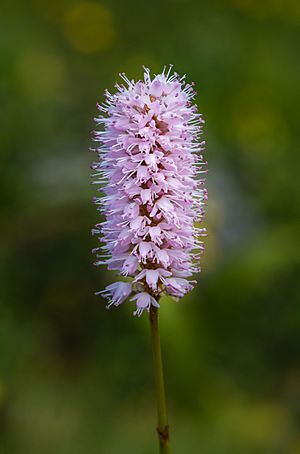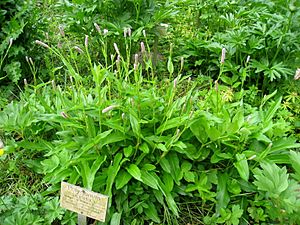Bistorta officinalis facts for kids
Quick facts for kids Bistorta officinalis |
|
|---|---|
 |
|
| Scientific classification | |
| Synonyms | |
|
Bistorta officinalis, also known as bistort or meadow bistort, is a pretty flowering plant. It is part of the dock family, called Polygonaceae. This plant naturally grows in Europe and parts of Asia. People also call it snakeroot or snakeweed because of its interesting roots. Another old name is Easter-ledges.
Contents
What Does it Look Like?
The bistort plant is a type of perennial herb. This means it grows back year after year. It can reach a height of about 20 to 80 centimeters (8 to 31 inches). It can also spread out about 90 centimeters (35 inches) wide.
It has a thick, twisted root that looks a bit like a snake. This is probably why it got the name "snakeroot." Most of its leaves grow from the base of the plant. These bottom leaves are long and oval-shaped with long stems. They have rounded or heart-shaped bases. The leaves higher up on the stem are fewer, triangular, and don't have stalks.
At the base of the leaves, there are small leaf-like parts called stipules. These are joined together to form a sheath around the stem. The leaf stalks, called petioles, are wide and flat.
The plant blooms from late spring until autumn. It grows tall, straight stems that don't have branches. Each stem ends in a single flower cluster, called a raceme. These clusters look like club-shaped spikes, about 5 to 7 centimeters (2 to 3 inches) long. They are full of rose-pink flowers.
Each tiny flower is pink and has five petal-like parts. It also has eight stamens (the parts that make pollen) and three carpels (the parts that make seeds). The fruit is a shiny black nut. Bistort usually flowers in June and July. It likes moist soil. If the soil gets too dry, the plant goes to sleep, losing its leaves until it gets enough water again.
Plant Names and History
Scientists have given this plant different names over time. It used to be called Polygonum or Persicaria. But now, most scientists agree its proper name is Bistorta.
Why is it Called Bistorta?
The name bistorta comes from two Latin words: bis (meaning "twice") and torta (meaning "twisted"). This name describes the plant's root, which often looks twisted.
Many old names for the plant have been recorded. Some of these names show how people used the plant, especially for making puddings! Here are a few interesting ones:
- Adderwort
- Dragonwort
- Easter giant
- Pink pokers
- Pudding grass
- Snakeweed
Where Does Bistort Grow?
Bistort is originally from Europe. But people have planted it in gardens all over the world. Sometimes, it escapes from gardens and starts growing wild in new places, like in New England in the United States. When a plant grows wild in a new area, it's called "naturalized."
You can usually find bistort growing in wet meadows, damp forests, along the edges of woods, in wetlands, parks, and gardens. It likes places where the soil has lots of nutrients.
Growing Bistort in Gardens
People often grow bistort as an ornamental plant in their gardens. This means they grow it because it looks pretty. There's a special type called 'Superba' that has even bigger and showier flowers. This 'Superba' variety has won an important award called the Royal Horticultural Society's Award of Garden Merit.
Bistort is great for planting along the edges of ponds or in bog gardens, which are wet garden areas. People have also grown bistort as a vegetable. Its roots, leaves, and young shoots can be steamed or boiled. Sometimes, the bistort you see growing wild might have originally come from someone's garden!
How People Use Bistort
For a long time, bistort has been used for medicinal purposes. The roots of the plant are rich in special substances called tannic acid and gallic acid. Both the roots and leaves have been used to help treat wounds.
In Northern England, people used to make a bitter pudding during the time of Lent. This pudding was made from bistort leaves mixed with oatmeal, egg, and other herbs. It's a main ingredient in a traditional dish called dock pudding or Easter-Ledge pudding. The root of bistort can also be used to make something called an astringent, which was also used in old medicines. People in Russia and northern Asia also eat the roots of bistort.
Gallery
-
Common bistorta, in Valais, Switzerland
-
The large-flowered cultivar Bistorta officinalis 'Superba' is grown as an ornamental plant.
See also
 In Spanish: Bistorta para niños
In Spanish: Bistorta para niños








